Are you seeking to traverse the stars with a Newtonian telescope?
With their unique design and affordability, Newtonian telescopes offer a doorway to the cosmos for both amateur and professional astronomers. Known for their reflective optics pioneered by Sir Isaac Newton, these telescopes are a favorite for capturing the enchanting details of distant galaxies and nebulae.
Well, we’ll be going over:
- How does the aperture size of Newtonian telescopes enhance the visual experience for stargazers?
- What role does the mount stability play in the effectiveness of a Newtonian telescope for tracking celestial objects?
- Can the focal ratio and quality of optics in Newtonian telescopes satisfy the demands of both amateur and serious astronomers?
Embark on a journey through the stars with this comprehensive guide to Newtonian telescopes.
Let’s dive in.
Top Picks for Newtonian Telescopes
- AstroMaster 114EQ – Top Pick
- Celestron StarSense Explorer
- Celestron AstroMaster 130EQ
- Solomark 130EQ Telescope
- Celestron 114LCM Telescope
In my search for stellar clarity and impressive magnification, I’ve evaluated a wide variety of Newtonian telescopes. My findings are distilled into a curated list of the best options available, focusing on optics, build quality, and user reviews. Whether you’re a budding astronomer or a seasoned stargazer, the following telescopes are sure to enhance your celestial viewing experiences.
AstroMaster 114EQ
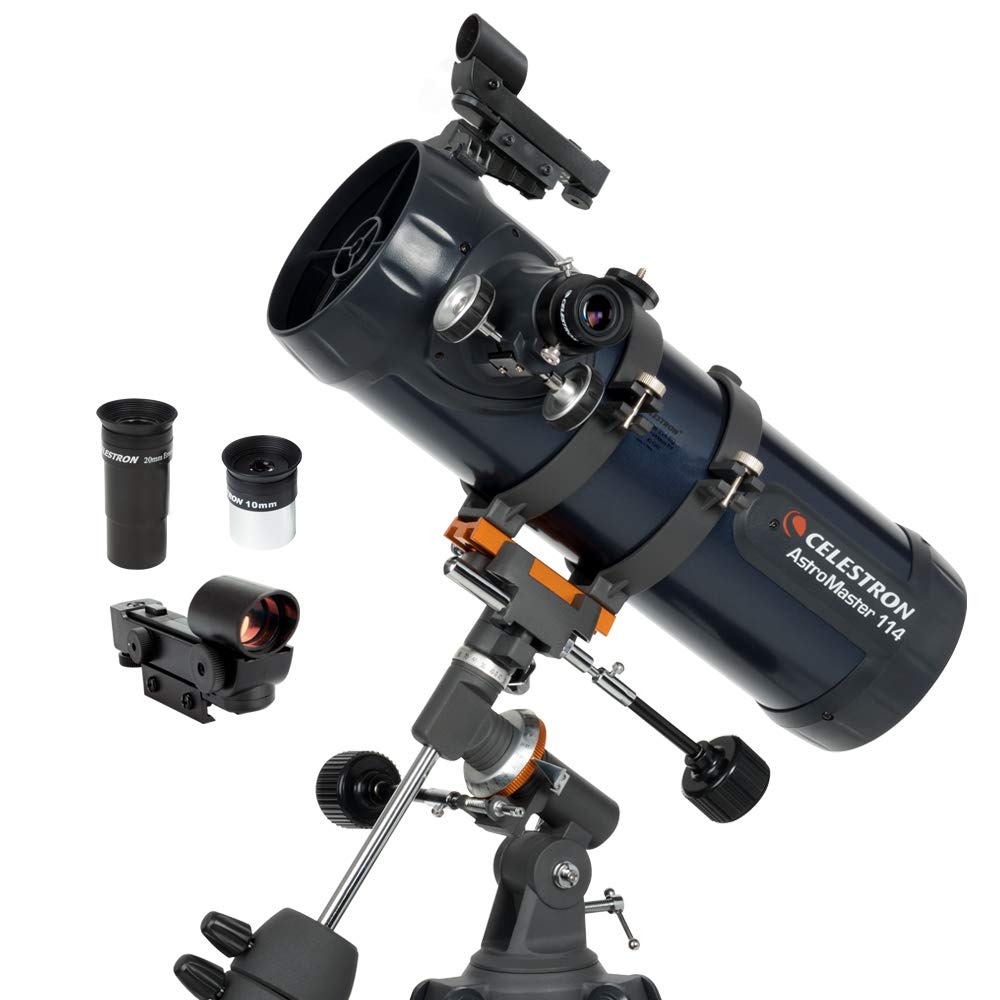
After a stargazing session with the AstroMaster 114EQ, I think it’s a fantastic entry-level telescope that strikes the right balance between ease of use and quality viewing.
Pros
Cons
Stepping out under the night sky, the AstroMaster 114EQ and I quickly became acquainted. Its initial assembly was a breeze, and in mere minutes, I was ready to indulge in the wonders above. The solidity of the tripod was immediately noticeable, promising an undisturbed gaze as I swept across the constellations.
Having the universe at my fingertips felt empowering, with Saturn’s rings coming into view through the eyepiece in striking detail. With the manual German Equatorial mount, I navigated the heavens, the slow-motion control knobs allowing precision adjustments as I tracked the celestial ballet.
The evening grew long, yet my comfort and satisfaction with the AstroMaster didn’t wane. Although it took a moment to get the hang of manual tracking, it became second nature with a little patience. Occasionally adjusting the finderscope became a small intermission in my cosmic exploration, reminding me of the small price to pay for such clear celestial views.
Celestron StarSense Explorer
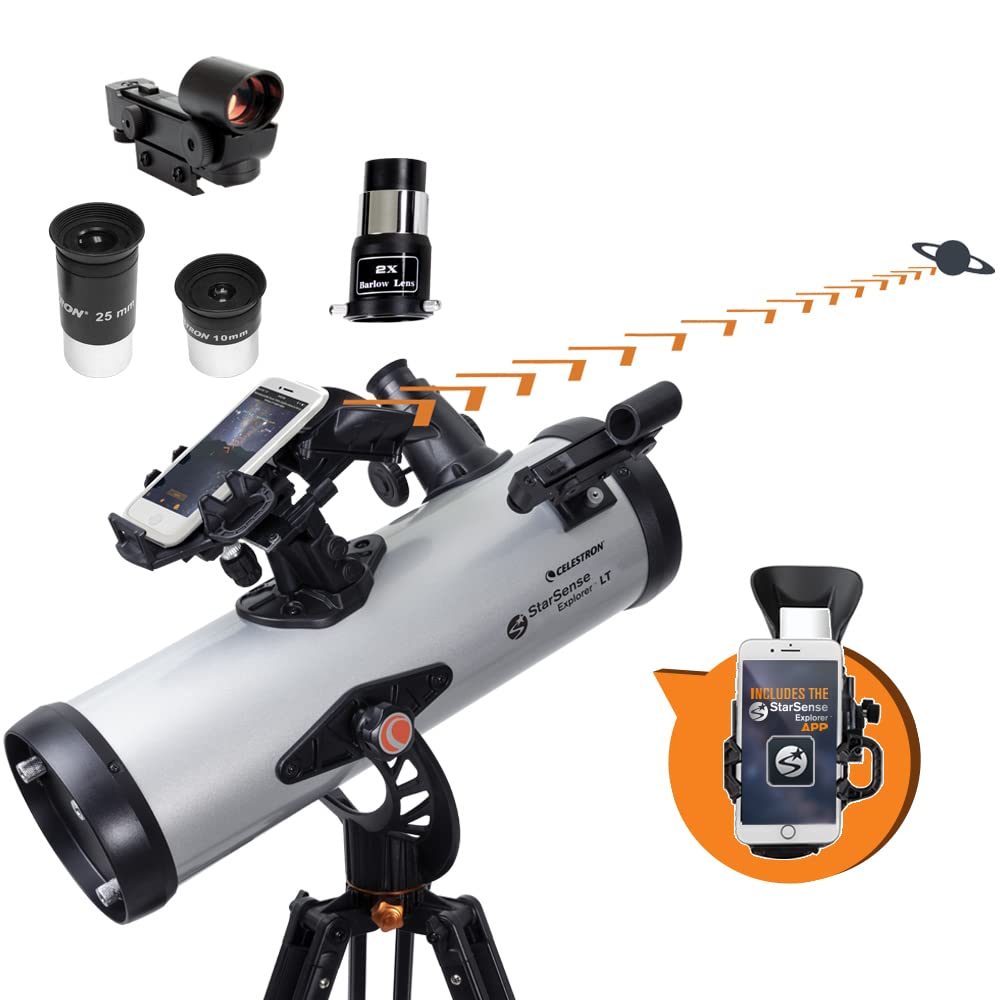
If you’re venturing into stargazing, the Celestron StarSense Explorer makes it an incredible journey, offering a seamless blend of technology and celestial discovery.
Pros
Cons
I recently had the chance to gaze at the night sky with the Celestron StarSense Explorer, and it was nothing short of mesmerizing. This telescope’s integration with modern smartphone technology provided a sense of direction and ease that’s hard to find in traditional models. Instead of fumbling with complicated manuals or star charts, I was outside, smartphone docked, and navigating the stars in no time. Even as a beginner, I found myself moving the telescope confidently under the guidance of the app’s arrows, hunting down celestial bodies that were once just names to me.
Using this telescope feels like unlocking a secret door to the cosmos. The app’s interactive interface is not just user-friendly; it’s like having a personal astronomy tutor. What struck me was the innovative use of the StarSense sky recognition technology. It calculates the telescope’s position in real time, letting me know exactly when my celestial target is visible in the eyepiece. That sigh of relief when the bullseye turns green and your object of fascination is in view? Undoubtedly a game-changer.
However, there are some things to consider. Being in an urban area limits the brightness and thus the range of objects you can view. But take this telescope to a darker locale, and it feels like a portal to another world. Yes, your experience hinges on your smartphone, but it’s a small trade-off for the telescope’s remarkable guidance system. I would recommend investing in auxiliary accessories, like a more robust tripod or additional eyepieces, to fully tap into the StarSense Explorer’s potential.
The Celestron StarSense Explorer gave me a new appreciation for the night sky, making astronomy more accessible and less intimidating. The thrill of aligning it just right and catching a glimpse of Jupiter’s bands or the craters on the moon with such ease is hard to replicate with traditional telescopes. It’s not just a tool; it’s an experience that enriches your understanding and love for the universe around us.
Celestron AstroMaster 130EQ
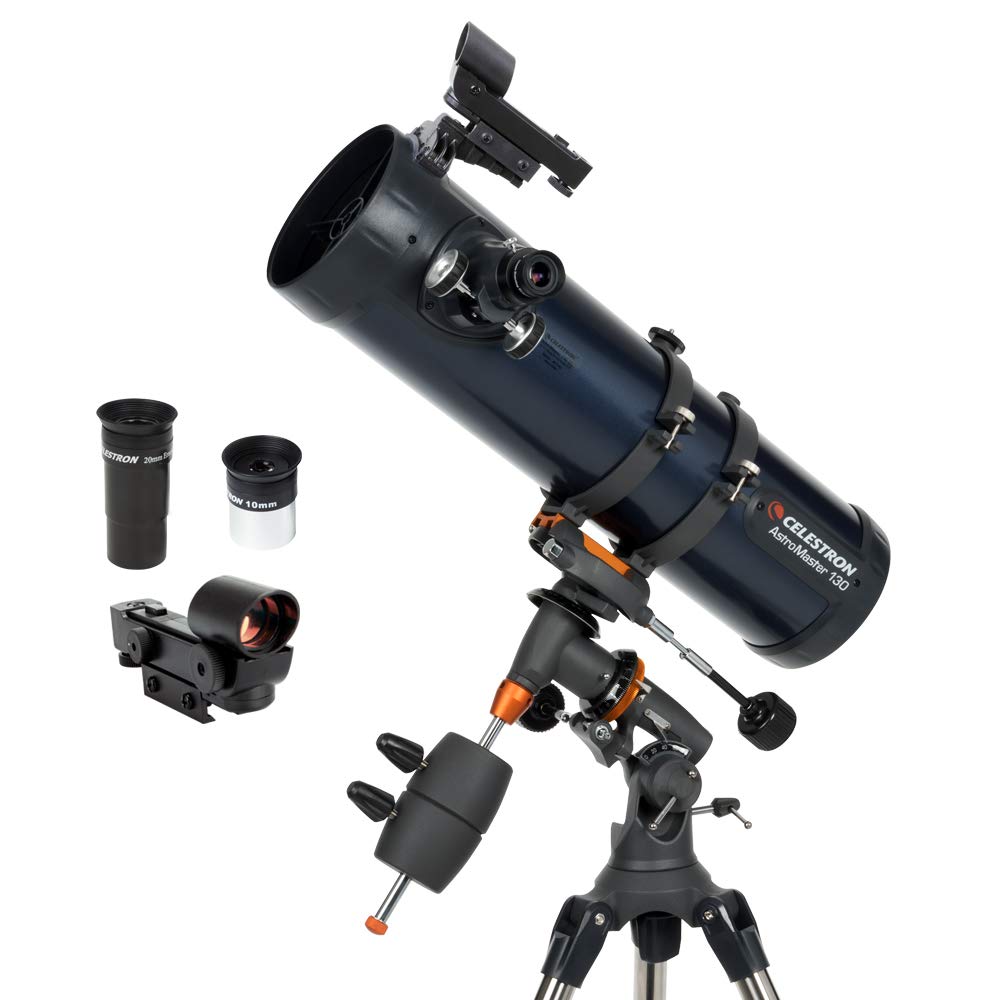
As an avid stargazer, I recommend the Celestron AstroMaster 130EQ for its simplicity, quality optics, and quick setup, making it an ideal choice for beginners.
Pros
Cons
After spending countless nights under the stars, I’ve come to appreciate telescopes that are straightforward and deliver clear, vivid images without fuss. When I first used the Celestron AstroMaster 130EQ, I was struck by how quickly I could get it set up. Its no-tool assembly is a genuine time-saver.
The optical performance has impressed me as well. On clear evenings, the fully-coated lenses provide such clarity that spotting Saturn’s rings and Jupiter’s moons becomes an awe-inspiring experience. Even deep-sky objects like nebulae come to life through the lens of this telescope. And during the day, its terrestrial capabilities allow for sharp, detailed observations of distant landscapes.
I did notice that aligning the StarPointer finderscope took a little time at first. But once I got the hang of it, navigating the night sky was a breeze. The sturdy tripod offers a stable base, although due to the mount’s manual nature, tracking objects across the sky requires a gentle and steady hand – something that new users will learn with time.
In summary, from the moment I set up the Celestron AstroMaster 130EQ, I knew I had a reliable companion for my astronomical adventures. Whether it’s the rings of Saturn or the craters on the Moon, this telescope brings the universe a little closer to home.
Solomark 130EQ Telescope
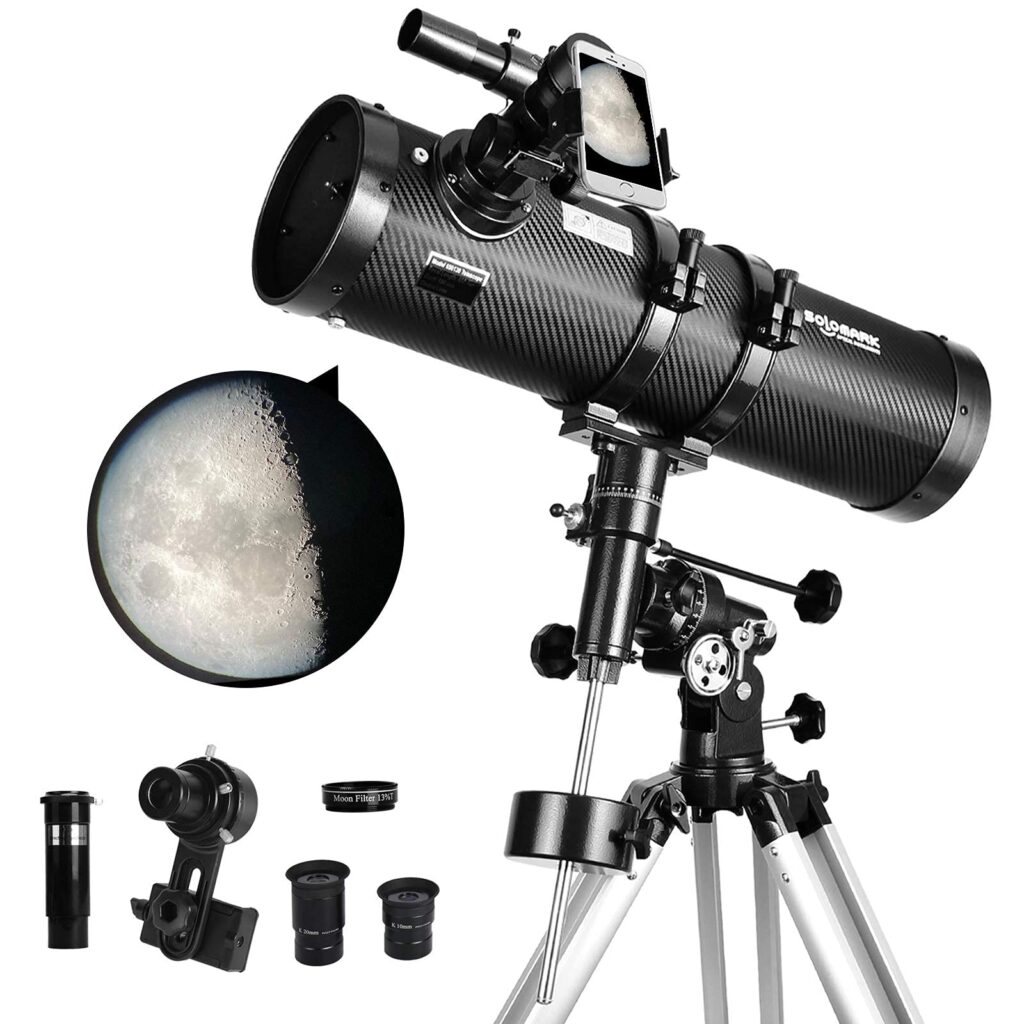
After a night of stargazing with the Solomark 130EQ Telescope, I’d confidently suggest it to anyone keen on delving into astronomy thanks to its crisp image quality and ease of tracking celestial objects.
Pros
Cons
The moment I unboxed the Solomark 130EQ, its sturdy frame and carbon fiber finish conveyed a promise of quality that certainly did not disappoint. With the fully-coated glass optics, the stars and planets I observed appeared more detailed than with other telescopes I’ve used in the past. This impressive clarity quickly reframed my perspective of the night sky.
As I aligned the telescope with Polaris, the German Equatorial Mount showed its true worth. Adjusting the dial and cables to track the steady march of constellations across the sky was intuitive. It was a genuine pleasure to watch Saturn’s rings slowly drift into view, and I appreciated the solid support of the adjustable aluminum alloy tripod throughout.
The telescope’s accessories also enriched my viewing experience. I snapped my smartphone into the included adapter and captured some of the celestial beauty, a feature particularly exciting for an amateur astrophotographer like myself. The extra eyepieces and the moon filter provided varying levels of magnification and detail, allowing me to tailor my observation to what I was most eager to explore.
In summary, the Solomark 130EQ offers a deeply satisfying stargazing experience and is a robust choice for both budding and seasoned astronomers. The combination of large aperture and quality optics make it a telescope that delivers on its promises, despite some minor assembly and portability considerations.
Celestron 114LCM Telescope
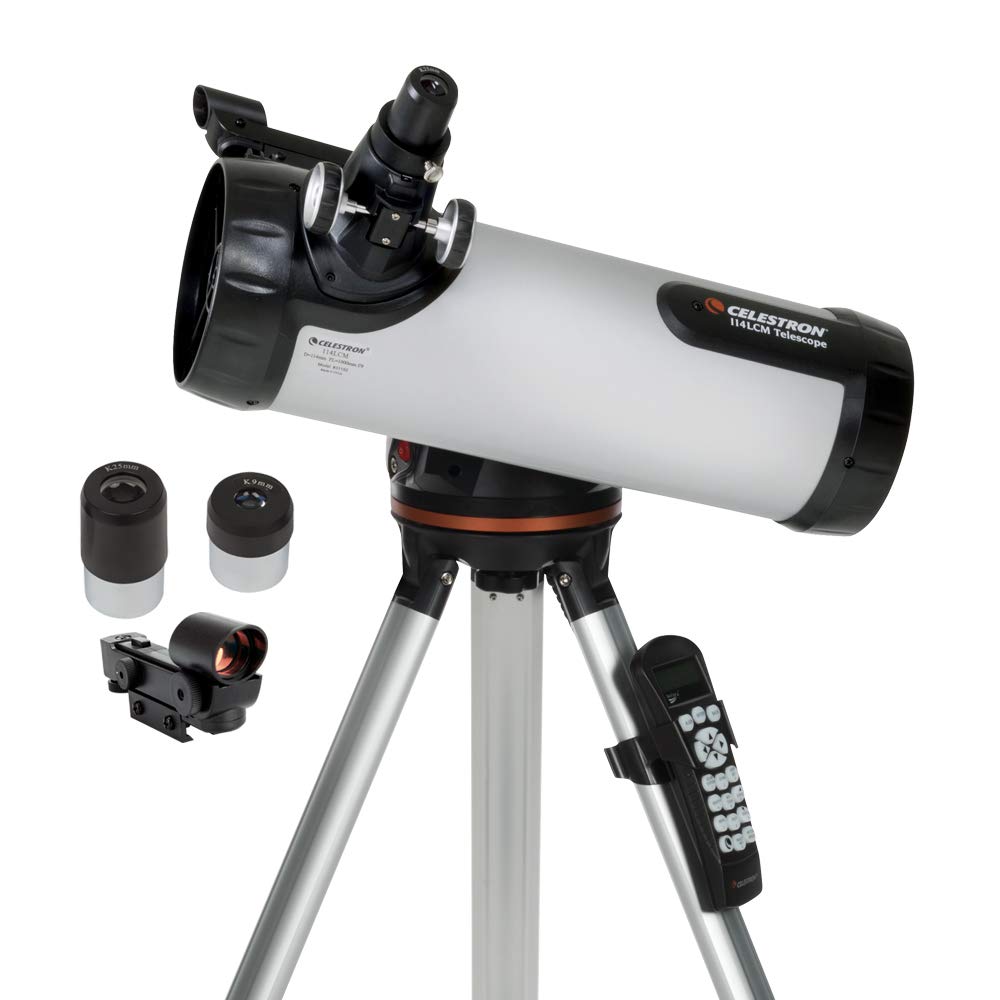
I found the Celestron 114LCM Telescope to be a fantastic tool for anyone keen on exploring the night skies, with automated features that greatly enhance the stargazing experience.
Pros
Cons
From the moment I unboxed the Celestron 114LCM, I could tell I was in for a treat. The setup was intuitive, which is a boon for those who, like me, are eager to get to the observing part. The computerized mount was a noticeable advantage, taking me on a guided tour of the night sky at the touch of a button. For someone who’s fumbled with manual mounts in the past, this feature is a game-changer.
Navigating the sky has never been easier. I remember being out there under the stars, the scope’s motor quietly whirring as it located Jupiter. The sight of the gas giant and its moons aligned perfectly in the eyepiece was nothing short of remarkable. It’s these moments that the 114LCM facilitates, making it a worthwhile companion for amateur astronomers.
Adjusting to the initial learning curve was expected. Orientation of the StarPointer and grasping the GoTo system’s full potential took a bit of time, but it was time well invested. Once everything was aligned correctly, finding various celestial bodies became a breeze. A word to the wise: patience pays off when getting acquainted with this telescope’s more advanced features.
In conclusion, the Celestron 114LCM stands out for its innovative features that truly bridge the gap between novice aspirations and expert-like observations. I can confidently recommend it to anyone looking to dive into the world of stargazing with a reliable and immensely user-friendly approach.
Buying Guide
Understanding Aperture Size
The aperture of a Newtonian telescope is its most critical feature, as it determines how much light can be gathered, affecting image brightness and detail. I recommend looking for a larger aperture to observe fainter and more distant objects.
Magnification and Focal Length
The relationship between the telescope’s focal length and the eyepiece defines the magnification power. I prefer a telescope with a long focal length for a more detailed view of my astrophotography subjects. Remember, extremely high magnification isn’t always beneficial due to atmospheric conditions.
| Focal Length | Ideal for |
|---|---|
| Short | Wide-field views |
| Medium | General astronomy |
| Long | Detailed views |
Mount Stability
A solid mount is crucial for a Newtonian telescope. The mount should offer stability and ease of use. I always ensure the mount is sturdy enough to hold the telescope without any wobble.
Portability Considerations
Depending on my observation plans, portability can be a key feature. Larger aperture telescopes tend to be bulkier, so consider how you’ll transport your telescope.
| Attribute | Importance for Portability |
|---|---|
| Weight | High |
| Size | High |
Accessories
High-quality accessories can enhance my viewing experience. I look for a telescope that includes a reasonable selection of eyepieces and a dependable finder scope to navigate the night sky.
Overall Quality
While keeping the cost in mind, I always choose quality over quantity. It is essential to ensure that the telescope is well-built, from the optics to the mechanical parts. Durable materials are a sign of a telescope that will last well into the future.
Frequently Asked Questions
In this section, I’ll address some common queries regarding the best Newtonian telescopes, tailored for various uses and budgets.
What are the best Newtonian telescopes for beginners interested in stargazing?
For beginners, the Orion SkyQuest XT4.5 Classic Dobsonian telescope stands out for its ease of use and excellent light-gathering capability. Another great choice is the Celestron AstroMaster 130EQ, which offers a good balance between affordability and performance.
Which Newtonian telescopes offer the best value for money?
The SkyWatcher Explorer 130P, known for its parabolic optics that reduce spherical aberration, is an exceptional model that provides great value for its cost. The Meade Instruments Polaris 130EQ is also a fantastic option that delivers good optics without breaking the bank.
What are the top choices for Newtonian telescopes in astrophotography?
For astrophotography, the Orion 8″ f/3.9 Newtonian Astrograph Telescope is highly regarded, designed specifically for deep-sky imaging. The SkyWatcher Quattro imaging Newtonian with its fast f/4 focal ratio is another top choice, ideal for capturing detailed astrophotos.
How does a Newtonian telescope compare to a Dobsonian for amateur astronomers?
A Newtonian telescope often uses a German equatorial mount providing precision tracking for astronomy, whereas Dobsonians are Newtonians on a simple alt-azimuth mount, ideal for their portability and ease of use. Both are excellent, with the choice depending on whether you prioritize tracking over simplicity.
What features should I look for in a Newtonian telescope for deep space observation?
For deep space observation, look for a Newtonian telescope with a large aperture, at least 8 inches, to collect ample light from distant objects. Also, consider one with a stable mount and high-quality mirrors to ensure sharp, clear images of nebulae and galaxies.
How do Newtonian telescopes perform compared to Refractor telescopes in terms of clarity and detail?
Newtonian telescopes generally offer more aperture for the price, which is crucial for capturing clear, detailed views of deep-sky objects. While refractors have no central obstruction, making for contrast-rich images, Newtonians manage to provide bright and sharp images at a lower cost.







